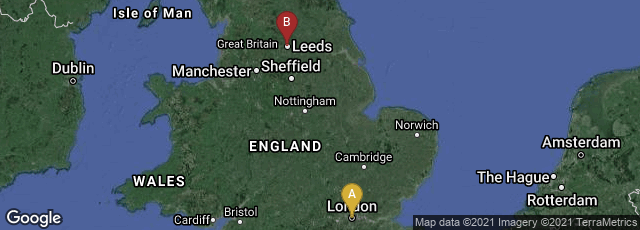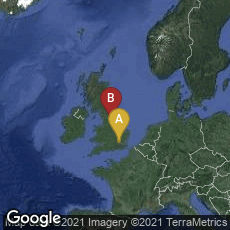

A: London, England, United Kingdom, B: Leeds, England, United Kingdom
George Walker's The Costume of Yorkshire (London: T. Bensley, 1814) contains 40 spectacular hand-colored aquatints mostly of workers in various trades. It is a deluxe production printed on fine paper, with texts in both English and French. The customers for this expensive book would have been from the upper class, so I find it ironic that the publisher would issue an illustrated account of regional costumes, including many of the working poor, for this market. The publisher, Thomas Bensley, was, coincidentally, one of the investors in Friedrich Koenig's pioneering steam-powered printing machine at this time. Walker's book, printed in a small edition, with the plates hand-colored, would, at this date, have been printed on a hand-press, probably of the Stanhope type.
Pertaining to the Industrial Revolution, plate 3 of "The Collier" is of special significance as including in the background the first representation of a steam-engine on rails, built by Matthew Murray & John Blenkinsop, Leeds in 1812, about two years before Stephenson's engine. Blenkinsop's engine, the Salamanca, was used to carry coal from the colliery of Charles Blandling into Leeds from 1812 to 1833. It operated on the Middleton Railway. The plate also includes a crude representation of the steam engine used to pump water out of the coal mine.
Another image relevant to the Industrial Revolution is plate 36 depicting "Factory Children." Perhaps surprisingly the author raises the issue of the impact of factory labor on the health of children. Here the text reads:
"A great part of the West Riding of Yorkshire abounds with cotton mills, cloth manufactories, and other large buildings appropriated to trade, which are now ususually known under the general, though perhaps vulgar, denomination of Factories. They are essentially requisite for the widely extended commerce of Britain, and furnish employment, food and raiment to thousands of poor industrious individuals. It is much however to be lamented that this is too frequently at the expense of health and morals. The little dirty group in the plate are painted in their true colors; but where in their complexions would the painter discover the blooming carnations of youth, or the valetudinarian, in the surrounding scenery, the pure air necessary for health? Many proprietors of factories have, much to their credit, remedied these evils by strict attention to the morals, behaviour and cleanliness of the children, by adopting the very easy and effectual plan of consuming the smoke" (p. 83).